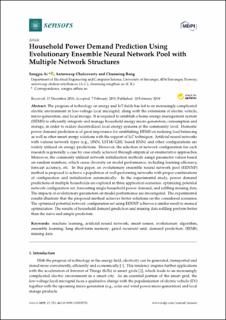| dc.contributor.author | Ai, Songpu | |
| dc.contributor.author | Chakravorty, Antorweep | |
| dc.contributor.author | Chunming, Rong | |
| dc.date.accessioned | 2021-02-22T08:35:48Z | |
| dc.date.available | 2021-02-22T08:35:48Z | |
| dc.date.created | 2019-06-13T15:04:17Z | |
| dc.date.issued | 2019-02 | |
| dc.identifier.citation | Ai, S., A., Chakravorty, C. Rong (2019) Household Power Demand Prediction Using Evolutionary Ensemble Neural Network Pool with Multiple Network Structures. Sensors, 19(3), pp. 1-19. | en_US |
| dc.identifier.issn | 1424-8220 | |
| dc.identifier.uri | https://hdl.handle.net/11250/2729369 | |
| dc.description.abstract | The progress of technology on energy and IoT fields has led to an increasingly complicated electric environment in low-voltage local microgrid, along with the extensions of electric vehicle, micro-generation, and local storage. It is required to establish a home energy management system (HEMS) to efficiently integrate and manage household energy micro-generation, consumption and storage, in order to realize decentralized local energy systems at the community level. Domestic power demand prediction is of great importance for establishing HEMS on realizing load balancing as well as other smart energy solutions with the support of IoT techniques. Artificial neural networks with various network types (e.g., DNN, LSTM/GRU based RNN) and other configurations are widely utilized on energy predictions. However, the selection of network configuration for each research is generally a case by case study achieved through empirical or enumerative approaches. Moreover, the commonly utilized network initialization methods assign parameter values based on random numbers, which cause diversity on model performance, including learning efficiency, forecast accuracy, etc. In this paper, an evolutionary ensemble neural network pool (EENNP) method is proposed to achieve a population of well-performing networks with proper combinations of configuration and initialization automatically. In the experimental study, power demand predictions of multiple households are explored in three application scenarios: optimizing potential network configuration set, forecasting single household power demand, and refilling missing data. The impacts of evolutionary parameters on model performance are investigated. The experimental results illustrate that the proposed method achieves better solutions on the considered scenarios. The optimized potential network configuration set using EENNP achieves a similar result to manual optimization. The results of household demand prediction and missing data refilling perform better than the naïve and simple predictors. | en_US |
| dc.language.iso | eng | en_US |
| dc.publisher | MDPI | en_US |
| dc.rights | Navngivelse 4.0 Internasjonal | * |
| dc.rights.uri | http://creativecommons.org/licenses/by/4.0/deed.no | * |
| dc.subject | maskinlæring | en_US |
| dc.subject | nevrale nettverk | en_US |
| dc.subject | artificial neural network | en_US |
| dc.subject | strømetterspørsel | en_US |
| dc.title | Household Power Demand Prediction Using Evolutionary Ensemble Neural Network Pool with Multiple Network Structures | en_US |
| dc.type | Peer reviewed | en_US |
| dc.type | Journal article | en_US |
| dc.description.version | publishedVersion | en_US |
| dc.rights.holder | © 2019 by the authors. | en_US |
| dc.subject.nsi | VDP::Teknologi: 500::Informasjons- og kommunikasjonsteknologi: 550 | en_US |
| dc.source.pagenumber | 1-19 | en_US |
| dc.source.volume | 19 | en_US |
| dc.source.journal | Sensors | en_US |
| dc.source.issue | 3 | en_US |
| dc.identifier.doi | 10.3390/s19030721 | |
| dc.identifier.cristin | 1704711 | |
| cristin.ispublished | true | |
| cristin.fulltext | original | |
| cristin.qualitycode | 1 | |

